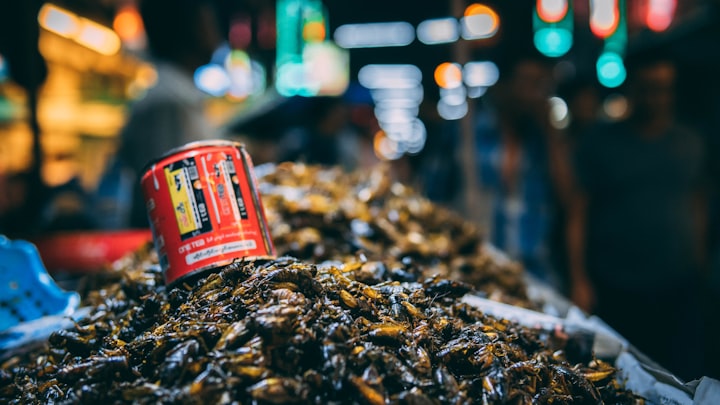Will the food industry rely on insects in the future?
It is possible that the food industry may rely on insects as a source of protein in the future. Insects are already consumed as a traditional food in many parts of the world, and they are a highly sustainable and environmentally friendly source of protein.

Here are some reasons why the food industry may increasingly turn to insects in the future:
Sustainability: Insects require much less land, water, and feed to produce the same amount of protein as traditional livestock such as cows, pigs, and chickens. This makes them a highly sustainable and eco-friendly source of protein.
Nutritional value: Insects are highly nutritious and contain high levels of protein, vitamins, and minerals. They also have a favorable fat profile, with high levels of healthy fats such as omega-3 fatty acids.
Versatility: Insects can be consumed in a variety of forms, such as whole or ground, and they can be incorporated into a wide range of foods such as protein bars, snacks, and baked goods.
Cost-effective: Insects are relatively cheap to produce and require minimal infrastructure to farm, making them a cost-effective alternative to traditional livestock.
Despite the potential benefits of using insects as a source of protein, there are still some barriers to widespread adoption in Western countries. One of the main challenges is consumer acceptance, as many people in Western countries may be hesitant to consume insects as a food source. However, as attitudes and awareness around sustainable food production continue to evolve, it is possible that the food industry may increasingly turn to insects as a protein source in the future.
The Benefits and Challenges of Using Insects as a Sustainable Protein Source in the Food Industry

Insects are increasingly being explored as a sustainable protein source for the food industry due to their high nutritional value, low environmental impact, and cost-effectiveness. However, there are also several challenges associated with the use of insects as a food source. Here are some benefits and challenges of using insects as a sustainable protein source in the food industry:
Benefits:
Sustainable and eco-friendly: Insects require much less land, water, and feed to produce the same amount of protein as traditional livestock such as cows, pigs, and chickens. They also produce fewer greenhouse gas emissions and waste.
Nutritious: Insects are highly nutritious and contain high levels of protein, vitamins, and minerals. They also have a favorable fat profile, with high levels of healthy fats such as omega-3 fatty acids.
Versatile: Insects can be consumed in a variety of forms, such as whole or ground, and they can be incorporated into a wide range of foods such as protein bars, snacks, and baked goods.
Cost-effective: Insects are relatively cheap to produce and require minimal infrastructure to farm, making them a cost-effective alternative to traditional livestock.
Challenges:
Consumer acceptance: Many people in Western countries may be hesitant to consume insects as a food source due to cultural and psychological barriers.
Regulation: There are currently limited regulations surrounding the production and processing of insects for human consumption, which could pose challenges for scaling up insect farming operations.
Health and safety: There is a need for further research on the safety and potential allergenicity of consuming insects.
Ethical concerns: Some people may have ethical concerns about the treatment of insects in the farming and processing process.
Overall, while there are several challenges associated with the use of insects as a sustainable protein source in the food industry, their potential benefits in terms of sustainability, nutrition, versatility, and cost-effectiveness make them a promising area for further exploration and development.
The Role of Consumer Acceptance in Shaping the Future of Insect-Based Foods in the Food Industry
Consumer acceptance is a critical factor in shaping the future of insect-based foods in the food industry. While insects are a highly sustainable and nutritious source of protein, they are not commonly consumed in many Western countries, and there may be cultural and psychological barriers to their adoption. Here are some factors that could influence consumer acceptance of insect-based foods in the food industry:
Familiarity and taste: One of the biggest barriers to the adoption of insect-based foods is the unfamiliarity of the taste and texture. As such, developing products that are familiar to consumers, such as insect-based protein bars, may help to increase acceptance.
Marketing and branding: Effective marketing and branding can help to change consumer perceptions of insect-based foods and position them as a sustainable and healthy alternative to traditional protein sources.
Education and awareness: Educating consumers about the nutritional and environmental benefits of insects can help to increase awareness and acceptance of these foods.
Regulatory support: Developing clear regulations and standards for the production and sale of insect-based foods can help to ensure their safety and quality and increase consumer confidence.
Cultural attitudes: Cultural attitudes towards insect consumption vary widely, and it may be necessary to target specific demographic groups who are more receptive to the idea of eating insects.
Overall, consumer acceptance is likely to play a significant role in shaping the future of insect-based foods in the food industry. While there may be challenges associated with increasing acceptance, targeted marketing, education, and regulatory support can all help to increase awareness and build consumer confidence in these products.
Innovations and Trends in Insect Farming for the Food Industry: Implications for Sustainability and Food Security
Innovations and trends in insect farming for the food industry are likely to have significant implications for sustainability and food security. Here are some examples of these trends and their potential implications:
Vertical farming: Vertical insect farming, where insects are raised in multi-story buildings, can maximize space utilization and reduce environmental impact by requiring less land and water. This approach could also lead to more consistent and controlled production of insects.
Automation and robotics: Automation and robotics can help to streamline insect farming operations, reduce labor costs, and increase production efficiency. This technology could also enable more precise control of insect diets and environments, leading to higher-quality products.
Genetic engineering: Genetic engineering can be used to improve the nutritional content and growth rates of insects, potentially making them even more efficient and sustainable protein sources.
Insect-based pet food: Insect-based pet food is already becoming popular due to the sustainability and nutrition benefits of insects, and this trend is likely to continue. This could create new markets for insect farming and increase overall demand for insect-based products.
Co-culture systems: Co-culture systems, where insects are raised in conjunction with other organisms such as bacteria or fungi, could help to reduce waste and increase nutrient cycling, leading to more efficient and sustainable production.
The implications of these trends for sustainability and food security are significant. Insect farming has the potential to provide a highly sustainable and nutritious source of protein that requires fewer resources and produces fewer greenhouse gas emissions than traditional livestock. Insect farming could also help to increase food security by providing a low-cost and easily scalable source of protein in regions where traditional livestock farming is not feasible. Overall, the innovations and trends in insect farming are likely to play an increasingly important role in the food industry in the coming years.
About the Creator
Furkan Ceylan
Freelancer Architect, Interior Designer, NFT producer, Speaker, Content Writer
Reader insights
Outstanding
Excellent work. Looking forward to reading more!
Top insights
Compelling and original writing
Creative use of language & vocab
Easy to read and follow
Well-structured & engaging content
Excellent storytelling
Original narrative & well developed characters
Expert insights and opinions
Arguments were carefully researched and presented
Eye opening
Niche topic & fresh perspectives
Heartfelt and relatable
The story invoked strong personal emotions
Masterful proofreading
Zero grammar & spelling mistakes
On-point and relevant
Writing reflected the title & theme






Comments (2)
Very Nice!
Nice work! I appreciate your effort.